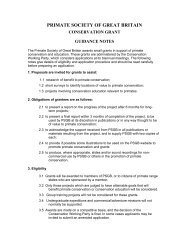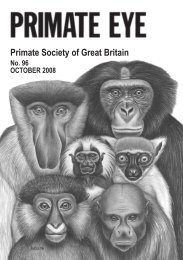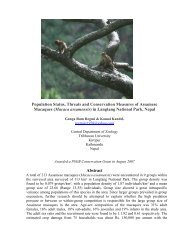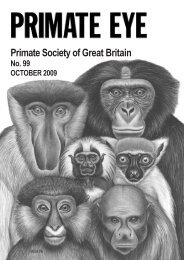2010 Vol 101.pdf (1.63mb) - Primate Society of Great Britain
2010 Vol 101.pdf (1.63mb) - Primate Society of Great Britain
2010 Vol 101.pdf (1.63mb) - Primate Society of Great Britain
Create successful ePaper yourself
Turn your PDF publications into a flip-book with our unique Google optimized e-Paper software.
for large brains. However, those groups characterized by strong<br />
encephalisation signals were also likely to show bonded, stable sociality<br />
amongst extant species. Some non-social groups, particularly amongst the<br />
carnivores, also showed strong evidence <strong>of</strong> encephalisation. These results<br />
finally are put into the context <strong>of</strong> conventional ecological and social<br />
explanations <strong>of</strong> brain size increase. I will also discuss encephalisation in<br />
primates versus other mammals.<br />
Clinal patterns <strong>of</strong> crani<strong>of</strong>acial morphology in baboons (Papio spp.): a<br />
geometric morphometric approach<br />
J. Dunn 1 , A.Cardini 2 and S. Elton 1<br />
1. Hull York Medical School, The University <strong>of</strong> Hull, 2. Museo di<br />
Paleobiologia e dell’Orto Botanico, Universitá di Modena e Reggio Emilia,<br />
Italy<br />
Clinal variation in morphology is found in several primate species, yet the<br />
ecological underpinning <strong>of</strong> these trends is unknown. Recent research on<br />
African monkeys has discovered a trend common to three disparate taxa.<br />
Blue monkeys, vervets and red colobus monkeys all exhibit a decreasing<br />
size cline from Central to East Africa. This raises the question which other<br />
species exhibit similarities in this clinal pattern and what can be learnt by<br />
comparing these patterns? The baboon has an extensive geographical range<br />
and exhibits subspecific diversity lending itself well to the exploration <strong>of</strong><br />
clinal variation. This study uses a trend surface analysis to visualise and<br />
quantify the clinal trend. Environmental factors <strong>of</strong> known significance in<br />
baboon ecology are included in a partial regression along with spatial terms<br />
allowing the effects <strong>of</strong> the two factors to be quantified. The morphological<br />
cline is separated into its allometric and nonallometric components. Size is<br />
found to decrease from Central to East Africa in baboons as with red<br />
colobus, vervets, and blue monkeys. Comparing allometrically and<br />
nonallometrically controlled clines reveals that most <strong>of</strong> the observed<br />
morphological diversity in baboons is the result <strong>of</strong> size only. Taxa<br />
considered outliers in size, such as the Kinda baboon, cease to be such when<br />
allometry is controlled for. However, some clinal patterning remains but<br />
along a north-south axis and is perhaps indicative <strong>of</strong> a more ancient<br />
diversification in morphology. These observations should aid further<br />
research on determining the mechanisms underpinning clinal variation.<br />
Ecological and life history considerations related size are discussed.<br />
12






